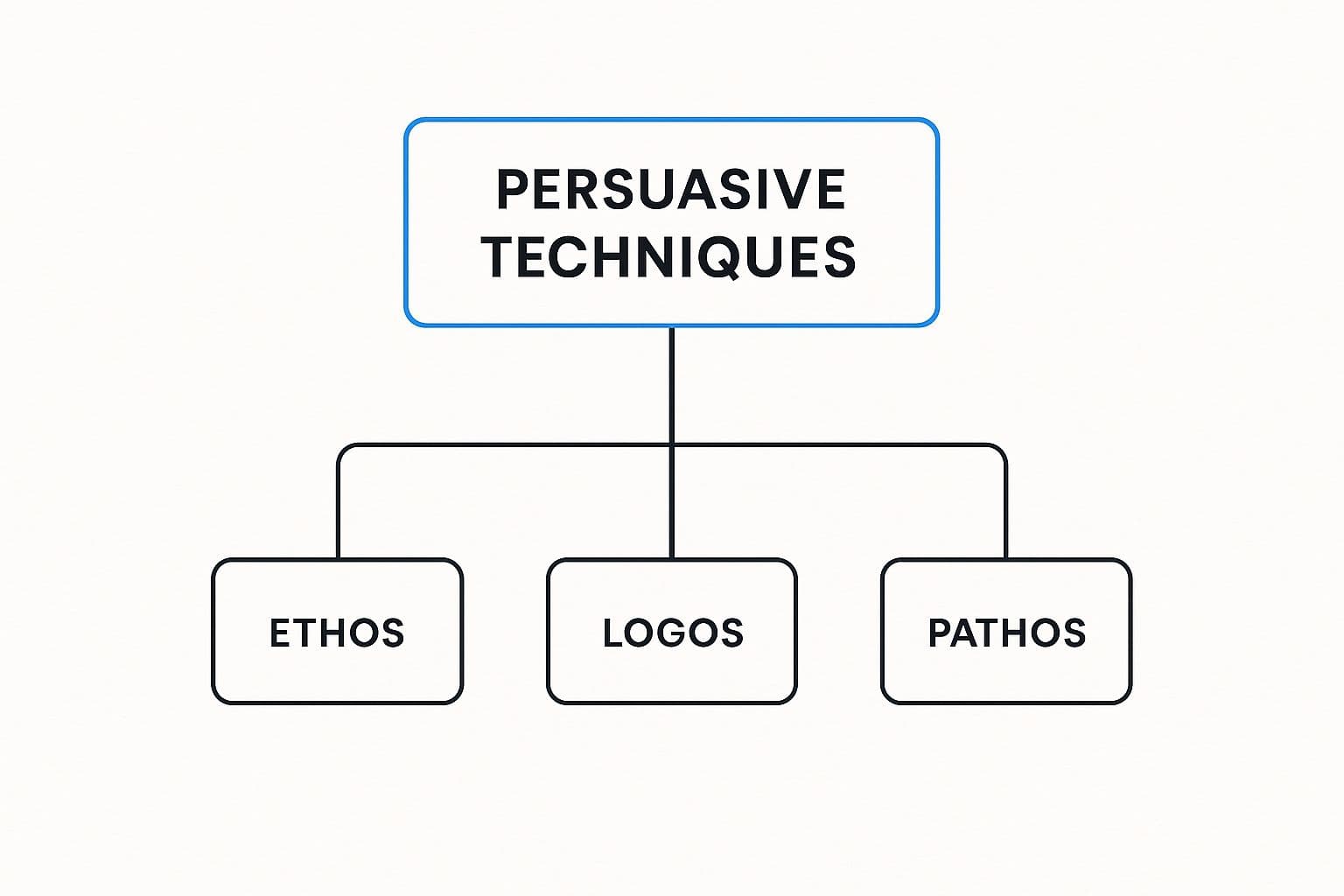Persuasive Techniques in Writing to Win Over Readers
Learn persuasive techniques in writing that actually work. Discover how to use ethos, pathos, and logos to craft compelling arguments that convert and convince.

At its heart, persuasive writing is all about getting a reader to see things your way or to take a specific action. These aren't some stuffy, academic theories locked away in a textbook. They're practical tools—everything from using emotional language to laying out a stone-cold logical argument—that give your words real impact.
What Are Persuasive Techniques in Writing?
Let's get real for a second. We all use persuasion constantly. Think about the last time you tried to convince your friends which movie to see, or when you carefully worded an email to your boss hoping for a "yes." In those moments, you were trying to bring someone around to your point of view.
Persuasive writing just gives those natural instincts a bit of structure and purpose.
It’s like building a case in a courtroom. You can't just walk in, state your opinion, and expect the jury to nod along. No way. You have to back it up. You’d bring in evidence, maybe tell a compelling story, and show exactly why your argument is the one that holds water. That’s the core of persuasive writing.
The Three Pillars of Persuasion
Dig a little deeper, and you'll find that nearly every persuasive argument stands on three ancient pillars identified by Aristotle more than 2,000 years ago: Ethos, Pathos, and Logos. The Greek names might sound intimidating, but I promise you already know these concepts by heart.
- Ethos (Credibility): This is all about your authority and trustworthiness. It’s your “street cred.” It answers the reader’s unspoken question: “Why should I listen to you?” You build Ethos by showcasing your expertise, writing with confidence, and proving you’re a credible source.
- Pathos (Emotion): This one speaks directly to the heart. Pathos connects with a reader's feelings—their joys, their fears, their hopes, and their dreams. A powerful story that makes someone feel something? That's pure Pathos at work.
- Logos (Logic): Here’s where you appeal to your reader’s brain. Logos is all about using cold, hard facts, statistics, evidence, and well-reasoned arguments to build an ironclad case. It answers the question: “Does this actually make sense?”
This simple diagram shows how these three pillars are the bedrock of persuasion.

As you can see, Ethos, Pathos, and Logos aren't isolated islands. The real magic happens when you weave them together. Think about it: the most convincing arguments rarely rely on just one. A powerful essay doesn’t just throw data at you (Logos); it frames that data with a human story (Pathos) and is delivered by a believable source (Ethos).
To help you keep these straight, here's a quick cheat sheet.
The Three Pillars of Persuasion at a Glance
| Appeal | Core Concept | What It Does for Your Writing |
|---|---|---|
| Ethos | Credibility & Trust | Establishes you as a trustworthy authority worth listening to. |
| Pathos | Emotion & Feeling | Creates an emotional bond and makes your reader feel your message. |
| Logos | Logic & Reason | Builds a rational, undeniable case using facts and evidence. |
By mastering these three, you're not just writing—you're building a foundation for truly powerful communication. Learning how to blend them effectively is key, and you can see how this works by exploring the proper structure of a persuasive essay.
Why Ancient Greek Ideas Still Rule Persuasion

To really get a grip on persuasive writing, we have to go way back. I’m talking long before social media, viral ads, or even the printing press. A Greek philosopher named Aristotle basically wrote the playbook on persuasion around 350 BCE. His work, Rhetoric, laid out a framework that is, frankly, still shocking in its relevance today.
This wasn't just some dusty old philosophy, either. It was a practical guide for ancient rockstars of rhetoric like Cicero and Pericles. They were the ones using these very principles to move massive crowds, shape public policy, and build empires. Their stage was the public square, but their methods are the same ones you see in Super Bowl ads and viral TikTok videos.
The big idea here is that persuasion isn't some dark art. It’s all about understanding human psychology. What makes people trust you? What gets them fired up? What makes them nod their heads and think, "Yeah, that makes total sense"? Aristotle boiled it all down to the three appeals we've been talking about: ethos, pathos, and logos.
Timeless Strategies for Modern Messages
Sure, the tools have changed from stone tablets to smartphones, but the human brain hasn't. That’s precisely why these ancient Greek concepts are still the bedrock of great communication.
Let's look at a then-and-now comparison:
- Then: An orator like Pericles would build his ethos by reminding the Athenian assembly of his long track record of service to the city. He was establishing his street cred before making his big ask.
- Now: A brand slaps customer testimonials and five-star reviews all over its website. It's the exact same play—proving they're trustworthy.
- Then: A speaker would stir up pathos by telling a gut-wrenching story of a fallen soldier to spark patriotism and get citizens to back a war.
- Now: A charity’s video ad shows you a shivering puppy with sad eyes to pull at your heartstrings and get you to donate.
The technology is worlds apart, but the appeal to credibility and emotion is identical. These strategies are just wired into us.
Aristotle's framework is so potent because it taps into the whole human experience—our need for trust (ethos), our emotional core (pathos), and our desire for things to just make sense (logos).
The Enduring Power of a Balanced Argument
The real genius of this ancient model is its balance. Modern research just keeps confirming what Aristotle knew all along: arguments that weave all three appeals together are way more powerful. In fact, some studies show that speeches mixing ethos, pathos, and logos can bump up audience agreement by as much as 50%.
Think about it. A lawyer's credibility (ethos) is massive; we know that perceived trust can sway a jury's verdict by up to 70%. At the same time, emotional engagement (pathos) makes a message stick in our brains.
At the end of the day, understanding these roots shows you that persuasive writing isn’t about tricking people. It’s about making a genuine connection on a deeply human level. If you really want to go down the rabbit hole, digging into some foundational marketing books on influence and persuasion is a great next step.
Putting Ethos, Pathos, and Logos to Work
Alright, so you know what ethos, pathos, and logos are. That's the easy part. The real magic happens when you start weaving them together in your writing—that’s where you go from just informing to actually persuading someone.
Think of it like being a great cook. You know a balanced dish needs salt (logos), fat (ethos), and acid (pathos). But just dumping them in a bowl won’t work. The art is in the blend, the timing, and knowing just how much of each to use.
Let's get practical and break down how you can put these powerful appeals to work with real-world strategies.
Building Your Credibility with Ethos
Ethos is all about trust. If your audience doesn't see you as a credible source, anything else you say—no matter how logical or emotional—is just noise. You have to earn their trust before you can earn their attention.
Here are some concrete ways to build up your ethos:
- Showcase Testimonials and Social Proof: Let other people do the bragging for you. A glowing customer review, a detailed case study, or a shout-out from a respected person in your field works wonders. When someone else vouches for you, it just hits differently.
- Cite Credible Sources and Experts: Back up what you're saying. Link to studies, quote well-known experts, and reference official data. This does more than just borrow their authority; it shows you've done your homework and are part of the larger, credible conversation.
- Be Transparent and Honest: This one is huge. Go ahead and acknowledge the other side of the argument or a potential downside to your solution. Nothing is perfect, and admitting that shows confidence. It disarms skeptical readers and makes them surprisingly more open to what you have to say.
Think about a software review site. It doesn't just say, "This app is great." It builds ethos by showing its work: "We tested this on three different machines, ran 15 performance benchmarks, and stacked it against four top competitors. Here’s the data." That’s how you build real trust.
Creating an Emotional Connection with Pathos
Pathos is what makes your message memorable. Logic makes people think, but emotion makes them act. It’s the difference between seeing a dry statistic about hunger and hearing the personal story of a family that moves you to actually pull out your wallet.
A powerful emotional appeal doesn’t just tell the audience what to feel; it creates a scenario where the feeling is a natural response. It’s about showing, not telling.
To tap into pathos effectively, try these techniques:
- Tell a Compelling Story: Our brains are fundamentally wired for stories. A narrative about one person’s struggle and eventual triumph will always be more powerful than a spreadsheet of abstract numbers. Find the human story in your message.
- Use Vivid and Sensory Language: Don't just say a situation was "bad." Paint a picture. Use words that trigger the senses—sight, sound, smell, touch. Instead of "the program helped people," try something like, "families could finally feel the warmth of their own homes, safe from the biting winter wind."
- Appeal to Hopes, Fears, and Aspirations: Connect your message to what your audience deeply cares about. Do they dream of a better future for their kids? Do they fear being left behind? Position your argument as the bridge to their hopes or the shield against their fears.
A classic example is any nonprofit asking for donations. They rarely lead with statistics. Instead, they tell you the story of a single child whose entire life was changed by a $25 donation. That one story does more persuasive heavy lifting than a dozen charts ever could.
Constructing an Airtight Argument with Logos
Logos is the logical skeleton that holds your entire argument up. It's the cold, hard proof that satisfies the rational part of your reader's brain. While pathos might create the desire to believe you, logos gives them the permission to. Without it, even the most heartfelt appeal can feel manipulative.
To effectively put persuasive techniques to work and ensure your message resonates, understanding your audience is paramount. For practical tips for improving social media engagement, you can find helpful guidance that aligns with building these connections.
To make your logos rock-solid, focus on these elements:
| Technique | How to Apply It |
|---|---|
| Use Hard Data and Statistics | Get specific. Numbers, percentages, and hard data make your claims feel concrete. Don't say "many users," say "78% of users reported..." |
| Provide Clear Evidence | Back up every major point with something verifiable—a case study, research findings, or a direct example. Let the evidence speak for itself. |
| Create a Logical Flow | Guide your reader through your reasoning, step-by-step. Use transitions like "because of this," "this leads to," and "therefore" to connect the dots for them. |
Imagine a tech company launching a new laptop. They can't just sell the "feeling" of using it (pathos) or rely on their brand name (ethos). They need to hit you with the logos: "20% faster processing speed, a battery that lasts 18 hours, and a screen with 3.5 million pixels." These are undeniable facts that build a rational case for why their laptop is the superior choice. You aren't just buying a vibe; you're buying proven performance.
5 Advanced Persuasive Techniques You Should Master

So, you've got the basics of ethos, pathos, and logos down. What's next? It's time to add some more sophisticated layers to your writing. Think of these advanced techniques as the fine-tuning that takes a decent argument and makes it truly compelling.
These aren't just tricks; they're the tools that help you subtly guide your reader's thinking and forge a much deeper connection. They are what make your message not just heard, but felt.
Use Rhetorical Questions to Guide Your Reader
You’ve seen these everywhere. A rhetorical question isn’t about getting an answer; it’s about making a point. You’re planting an idea in your reader's mind, letting them arrive at the conclusion you want them to reach—all on their own.
When you ask something like, "Are we really going to let this opportunity pass us by?" you're not actually looking for a "yes" or "no." You’re framing the situation as urgent and making the alternative seem foolish. It's a brilliant way to build agreement without sounding bossy.
These questions are effective because they make the reader an active participant. Instead of just taking in information, their brain automatically starts chewing on the implied answer, which makes your point far more memorable and personal.
Make Abstract Ideas Concrete with Metaphors and Similes
Let's be honest, complex ideas can be a tough sell. Metaphors and similes are your best friends here. They work by latching an unfamiliar concept onto something your reader already knows and understands.
- Metaphor: "This new software is a rocket ship for our productivity." (It’s not actually a rocket, but you instantly get the idea of incredible speed and power.)
- Simile: "Using the old system was like trying to run through quicksand." (The "like" instantly paints a picture of a slow, frustrating, and messy experience.)
By creating these mental shortcuts, you turn abstract concepts into something tangible and sticky. This is a core skill for anyone who wants to seriously improve their writing skills and ensure their arguments hit home.
Tap into Deeper Emotional Appeals
Going beyond general pathos, you can zero in on specific, universal emotions that are hardwired into all of us. These appeals act as a direct line to your reader's heart by tapping into feelings we all share.
The best persuasion doesn't just state a case. It wraps that case in a feeling the audience already recognizes, creating an instant connection.
Think about it. Appeals to nostalgia, that sentimental longing for the good old days, can boost a campaign's approval rating by up to 35%. Tapping into patriotism and national pride is a proven way to get people to the polls. And a heartfelt appeal to sympathy? That can increase charitable donations by a whopping 43%.
When you combine these powerful language tools with a solid foundation of ethos, pathos, and logos, you're not just making a point anymore. You're crafting an experience—one that guides, resonates, and convinces.
It's easy to talk about persuasive writing techniques in theory, but what do they actually look like out in the wild? Can a single piece of writing really change the world?
For the answer, let's jump back to 1776. The American colonies were a simmering pot of frustration and dissent, but there was no single, unified cry for independence. Not yet, anyway.
Then came Thomas Paine and his 47-page pamphlet, "Common Sense." This wasn't just some stuffy political essay. It was a masterclass in persuasion that completely flipped public opinion on its head and paved the way for a new nation. Paine's work is a powerful reminder that the right words can do more than just make a point—they can start a fire.
What was Paine's secret? He didn't try to impress anyone with fancy, academic language. Quite the opposite. His real genius was in making his argument so clear and simple that anyone, from a farmer to a shopkeeper, could get on board. He masterfully wove together the very same persuasive appeals we've been exploring.
The Logic of Independence
First, Paine laid out a rock-solid case using Logos (logic). He didn't just yell, "Britain is bad!" Instead, he walked his readers through the argument, step-by-step, using plain, common-sense reasoning.
He pointed out how absurd it was for a massive continent to be ruled by a small island thousands of miles away. He laid out the economic pains and the sheer foolishness of waiting months for a king across the ocean to make a decision. Each point was another logical brick in a wall that was nearly impossible to tear down.
The Feeling of Freedom
But logic on its own doesn't usually spark a revolution. This is where Paine's true brilliance shines: his use of Pathos (emotion). He took a dry political debate and turned it into a deeply personal and emotional crusade.
He used vivid, stirring language to paint a picture of freedom not as some abstract concept, but as a right everyone could feel in their gut. He framed the fight for independence as a heroic, urgent mission to create a better world, one free from the shackles of tyranny. This gave people something to believe in and fight for, not just something to complain about.
Paine’s writing gave a voice to the unspoken feelings of thousands, turning quiet frustration into a loud, unified demand for freedom. He made independence feel not just logical, but necessary and inspiring.
The impact was stunning. The pamphlet spread like wildfire, selling an estimated 100,000 copies in just a few months. To put that in perspective, the entire colonial population was only about 2.5 million people. "Common Sense" was read aloud in pubs, homes, and town squares, supercharging the movement for a clean break from Britain. If you're curious, you can learn more about the historic impact of "Common Sense" and its writing techniques on Grammarly.
This moment in history is the ultimate case study for what persuasive writing can do. Paine didn't have a slick marketing campaign or a Twitter account. He just had a clear argument, powerful emotional language, and a deep understanding of his audience. He blended logic with feeling to change minds, drive action, and literally help write a new chapter in history.
Your Persuasive Writing Pre-Flight Checklist

Knowing the theory is one thing, but actually putting it to work is where the magic happens. Before you hit "publish" or fire off that important email, give your writing a quick once-over with this checklist. It's more than just a summary—it's your final quality control step to make sure your message truly lands.
Think of it as the final walkthrough before a big presentation. Asking these simple questions helps you catch weak spots in your draft and transform it from "pretty good" into something genuinely persuasive. Each point here is a practical way to apply the core techniques we've been talking about.
The Core Appeals Check
First things first, let's make sure your foundation is rock-solid. This part is all about checking for the three pillars of persuasion. If you answer "no" to any of these, it's a major warning sign that your argument could crumble.
- Ethos Check: Have I given them a reason to trust me? This isn't just about saying "trust me." It's about showing it—with solid data, a relevant personal story, or even a quote from someone they already respect.
- Pathos Check: Does my writing feel human? Scan your work for a story, a powerful word, or a vivid description that will make your audience feel something. People connect with emotion.
- Logos Check: Does my argument actually make sense? Your points need to flow logically from one to the next. Back them up with good reasoning or evidence so your reader can easily follow your train of thought to the conclusion.
It’s so easy to lean too heavily on just one of these. All logic, and you sound like a robot. All emotion, and you might come off as manipulative. The sweet spot is always in the balance.
Fine-Tuning Your Message
Okay, so the core structure is sound. Now it's time to polish your delivery. These final questions are about the specific words and framing that take your writing from clear to compelling.
- Is It Clear and Concise? If your reader gets confused, you've lost them. Hunt down and eliminate any jargon, fluff, or convoluted sentences that could cause even a moment of hesitation.
- Is There a Clear Call to Action? Be honest—what do you really want the reader to do, think, or feel after they finish reading? Make sure that next step is painfully obvious and simple to take.
- Have I Addressed Objections? Put yourself in the shoes of a skeptic. What would they push back on? Acknowledging potential doubts upfront shows you're confident and makes your argument that much stronger.
Making this checklist a habit will help these principles become second nature. It's how you shift from just getting words on a page to learning how to write professionally with real, consistent impact.
Got Questions About Persuasive Writing? Let's Clear Things Up.
Once you start digging into these persuasive techniques, a few questions always seem to surface. That’s a good thing. It means you’re thinking about how to use these powerful tools the right way—effectively and ethically. Let's tackle a few of the most common ones I hear.
Is Persuasion Just a Nicer Word for Manipulation?
This is the big one, and it's a fair question. The line between persuading and manipulating can feel a bit blurry, but it all boils down to two things: intent and transparency.
- Persuasion is about making your case. You’re using solid logic, genuine emotion, and your own credibility to convince someone that your point of view has merit. You respect their intelligence and their right to choose.
- Manipulation, on the other hand, is shady. It works by hiding the real goal, using sneaky tactics, or preying on someone’s insecurities to get a specific result. It’s about taking away their choice by tricking them.
Here’s a simple way to think about it: Persuasion is like a passionate lawyer laying out all the evidence for a jury. Manipulation is the con artist on the street corner with a shell game.
What’s the Single Most Important Technique for Online Writing?
If I had to pick just one, especially for the internet, it would be ethos, or credibility. In the endless sea of online content, everyone is subconsciously asking, "Why on earth should I trust you?" Before your brilliant logic or touching stories can have any effect, you have to prove you're a voice worth listening to.
Without a foundation of trust, the most well-reasoned argument or heartfelt plea will just be more noise. On the internet, credibility is everything.
You earn this trust by citing your sources, speaking plainly, and showing you actually know what you're talking about.
How Can I Actually Use This in a Simple Work Email?
You don't need to be writing a sales page or a big speech to put these skills to work. Persuasion is a secret weapon in everyday office communication.
Let's say you need a colleague to jump on a task for you, and you know they're swamped. Instead of just dropping it on them, try this approach:
- Kick off with Pathos: "I know you're slammed today, and I seriously appreciate you even looking at this for me." (This shows empathy and that you respect their time.)
- Follow up with Logos: "If you can get this report updated by 3 PM, we can get the client the data they need before their EOD deadline. That keeps the whole project from getting stalled." (This gives a clear, logical reason why it’s important.)
- Seal it with Ethos: "My part is done and dusted—I've attached it here for you." (This shows you're on top of your game and not just passing the buck.)
See? You've just turned a potential demand into a collaborative and completely reasonable request.
Ready to make your own writing more persuasive, without all the friction? TypeBoost lets you apply your favorite AI prompts to any text, anywhere on your Mac. Stop the endless copy-pasting and start creating clearer, more compelling content in seconds. Learn more and get started with TypeBoost.